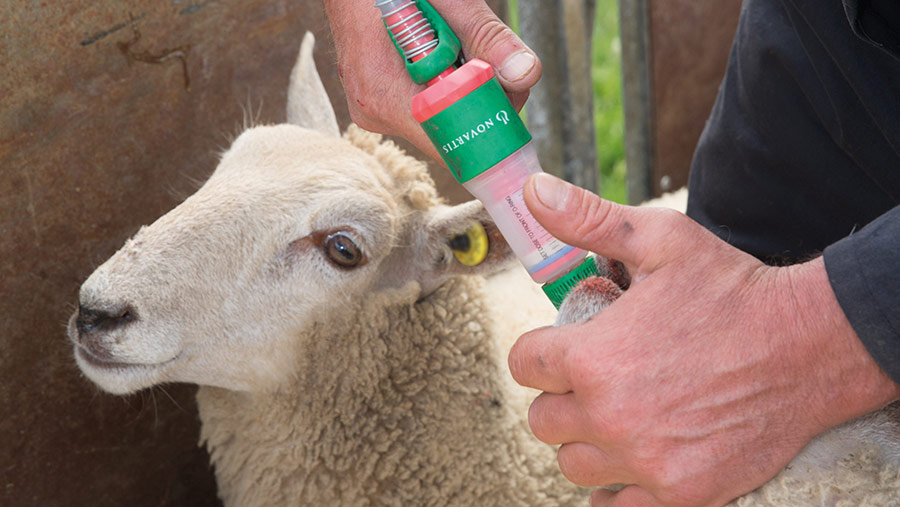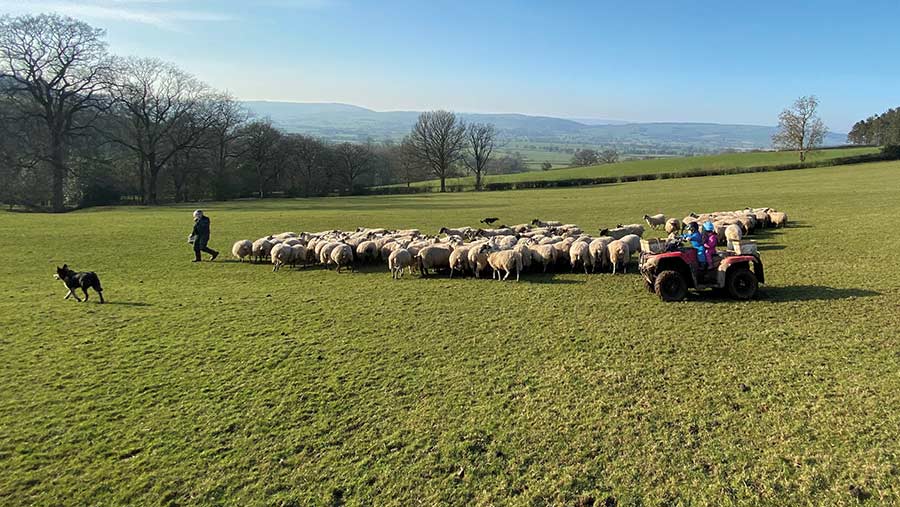Sheep sector calls for newer wormer use as resistance rises
 © Tim Scrivener
© Tim Scrivener Sheep farmers are being urged to start using the newer group 4-AD and 5-SI wormers to help slow an alarming rise in wormer resistance.
In an open letter to the sheep industry, the National Sheep Association (NSA), the Sustainable Control of Parasites in Sheep group (Scops), Moredun Research Institute, and the Sheep Veterinary Society (SVS), are calling for the wormer groups to be integrated into worm management plans immediately.
Parasitic gastroenteritis remains the number one killer of sheep by far, accounting for more than a quarter of deaths, according to carcass submissions from the veterinary investigation diagnosis analysis (VIDA) between 2005 and 2019. Yet research has highlighted a worrying increase in anthelmintic resistance on UK farms (see box 1).
See also: Ways to reduce worm burden through better grazing
NSA chief executive Phil Stocker warns the problem means some farmers may have to face a future without sheep until they overcome the problem.
Kevin Harrison, Gloucestershire sheep farmer and chairman of Scops, says: “Integrating the two newer groups into on-farm worming strategies will help slow the resistance to older groups, keeping them working for longer.”
Scops advises that group 4 or 5 is used on all sheep farms at two points in a worm-control plan. Mr Harrison sets out the ways in which these could be incorporated into management plans:
- As a quarantine treatment in all incoming sheep: To remove worms resistant to groups 1, 2 and 3. Treat sheep and house for 24-48 hours to prevent pasture contamination. View quarantine treatment options (PDF) on the Scops website.
- In the latter part of the grazing season as a mid-late season break dose: Target lambs that have had one or more treatments with the older three groups. Faecal egg counts (FECs) should be carried out first to determine need to treat.
- Leave lambs on dirty pasture for four to five days: Previously the advice has been to move lambs to clean grazing after treatment, but leaving them on dirty pasture allows the dilution of any surviving worms.
Mr Harrison adds: “Anthelmintic resistance is becoming a very complex issue and it shouldn’t just be down to the farmers to work it out. We need industry collaboration from the top.”
He calls on vets, sheep consultants and health advisers to work together to deliver the right advice to ensure farmers are using the “right product at the right time”.
Mr Harrison says farmers can’t hide from anthelmintic resistance, adding it is already on farm. But he says acting now is vital to prevent irreversible future resistance developing.
Resistance and why monitoring treatment efficacy is vital:
- In Scotland, resistance to group 1 white wormers has been found on 80% of lowland farms and 55% of upland farms, according to Moredun
- In England and Wales, group 1 white wormer resistance has been found on nearly 100% of lowland farms and 83% of upland farms, and group 2 (yellow) wormer resistance on 47% of lowland farms and 17% of upland farms, according to Scops
- Furthermore, reports of triple resistance to 1, 2 and 3 group wormers is increasing
- However, 85% of farmers still believe the wormers they use are working well, a recent Elanco survey of 380 farmers found.
- This is largely because most sheep farmers do not monitor treatment efficacy or growth rates and are not being alerted to this “invisible” problem, says Matt Colston, ruminant technical consultant at Elanco Animal Health.
Case study: Nigel Lloyd, Hollybush Farm, near Ludlow, Shropshire

© Hannah Lloyd
Introducing faecal egg counts (FECs) and evolving the worming protocols as part of a wider flock health plan has had a clear impact on lamb health and performance at Hollybush Farm.
In 2017, Nigel Lloyd started noticing his lambs were not thriving, even after worming. Upon consultation with his vet, at Marches Veterinary Group, he started carrying out FECs 10-14 days after worming and discovered wormer resistance was the issue.
Since then he has been proactively working with his vet, Emily Postlethwaite, to incorporate a sustainable worming regime into his annual flock health plan.
Changes to worming policy
As resistant worms can have a significant impact on lambs, reducing growth rates and in some cases leading to permanent gut damage or worse, a newer “orange” group 4 wormer was recommended to clear out the resistant worms in the mid-late grazing season.
“We now routinely treat our late season lambs with group 4 to wipe out any worms that are resistant to the other groups of wormers we’d been using, protecting their use for longer.
“Using an orange drench plays an important role as it clears out any resistant worms at the end of the season and means I can keep on top of the worm burden without increasing the level of resistance on my farm.”
Mr Lloyd also brings in North Country Mules and has recently introduced Cheviot ewes and Charollais tups to the flock, so has a set quarantine procedure in place with orange drench also used on incoming stock.
“We worm the new stock and keep them indoors, off pasture, for 48 hours to prevent any resistant worms being brought on to the farm,” he says.
Need to drench
As part of the wider flock health plan, all lambs are routinely weighed every two weeks to monitor growth rates and to flag any ill health before it becomes problematic.
FECs are taken to monitor worm burdens, especially any lambs that aren’t meeting targets.
“We work closely with Ms Postlethwaite to review the FEC results, and if necessary, she recommends a suitable treatment. For instance, in the spring, we generally treat with a white drench for nematodirus, as per the Nadis parasite forecast.
“After that, we treat according to the FEC results and the risk levels, rotating through the different anthelmintic classes to avoid resistance build-up,” he adds.
“We’ve definitely seen a reduction in the amount of drench required to keep the worm burden down since implementing the new regime. Lamb growth rates have improved too, meaning they reach our target 42kg market weight faster, and with less scouring too,” explains Mr Lloyds.
Farm facts
- Mixed farm with a suckler herd, sheep and bed-and-breakfast pigs on 52ha of grassland
- 250 ewes made up of a mixture of North Country Mules and Cheviots
- The North Country Mules are put to Suffolk rams with the ewe lambs put to Texels
- Newly introduced Charollais rams run with the Cheviot ewes
- Lambing starts in mid-March
- All lambs are sold liveweight at 42kg
